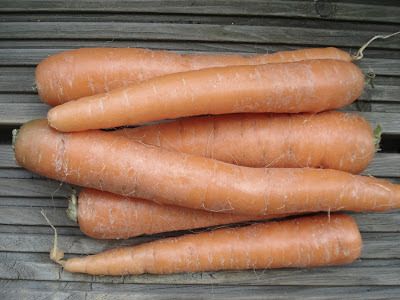Fabulous Favas
It's summer! Though you wouldn't know it if you lived in London. My brief saunter down to the flower market this morning began and ended in sunshine, but was interrupted by a massive downpour in the middle. Luckily I had an umbrella with me, as the sky seemed ominous when I left, but I wish I had the sense to wear my wellies...
Anyway, the calendar says it's summer, even if the skies are uncooperative and the mercury has trouble staying above 20°C/ 70°F. And fava beans are one of the many vegetables that screams summer. Also known as broad beans, or fèves, fava beans sometimes get a bad reputation because of the mealy texture of the frozen stuff. However, if you buy fresh beans, they are anything but floury. Fresh favas are close in texture to baby peas, but with a smooth, creamy mouthfeel, a little like fresh almonds.
Broad beans do have chewy inner skins: if you think peas are a hassle to shuck, wait til you try your hand at those massive beans that come to market in the summer! The British and North-Africans often eat the beans unpeeled, but I think you can can only get away with unpeeled beans if they are very young: anything under penny-size might be tender enough to eat skin and all, but when they reach quarter-size (10p), broad beans should be peeled, lest you want to develop a fervent hatred for them. Broad beans need to be shucked before cooking, but should be left in their jackets. Fresh favas are easily overcooked, so keeping them unpeeled will make it easier for you to fish them out of the pot. The tender green flesh can be revealed once they have cooled enough to handle.
Now the fun can begin... The peeled beans can be added to a pot of rice in its last twenty minutes of cooking to make a fava bean version of rice and peas, or you can smash them into a purée to slather over toasts like you would with hummus. The recipe for one may seem like an incredible amount of favas, but you mustn't forget that at least half the weight of the beans will be the pod itself. While you can substitutes any fresh bean or peas for the favas, I wouldn't use frozen broad beans unless they were of a really high quality (you wouldn't want to eat a floury purée).
Smashed Beans on Toast
Serves 1
500g/ ½ lb broad beans, more or less 250g/ ¼ lb beans
1 sprig of mint
chives, garlic scapes, or 1 small clove of garlic
salt and pepper
olive oil
1 lemon
slices of toasted bread
Shuck the beans, and set aside.
Bring a pot of water to the boil. (I usually keep the cooking water for my plants, so I never salt it, however, you can add salt if you want.)
Add the beans to the boiling water, and cook for a minute or two.
Drain the beans, and leave to cool.
Meanwhile, finely chop the mint, chives or garlic scapes; if you are using a garlic clove, grate it to avoid biting into a chunk of it, or simply scrape it across the toast's surface
Peel the cooled beans, and collect in a deep bowl.
Mash with a fork to obtain a rough purée.
Season with salt and pepper, add enough olive oil to loosen the mix, and fold in the mint and chives or garlic scapes.
Pile onto the awaiting toasts, and grate a lemon's zest overtop.
Dig in.
If you somehow end up with too little bean purée, you can stretch out the mix with a soft cheese, such as ricotta, cream cheese, quark or a fresh goat's cheese. Garlic scapes would be magical with fava beans or peas, but I haven't seen any in London; the farmers' markets across North America should have piles of them right about now. Alternatively, if you leave the garlic out, the beans can be served up as baby food.
Bon app'!








Comments
Post a Comment